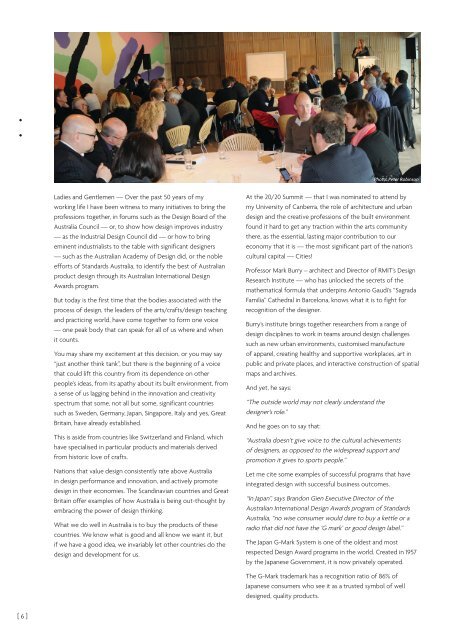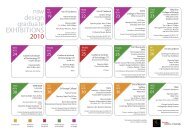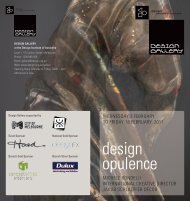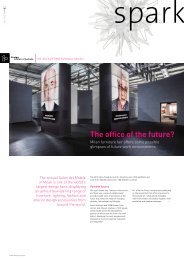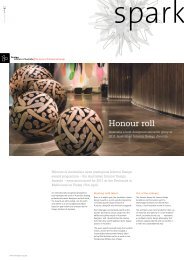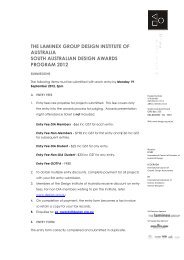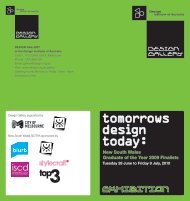Launch Report - Design Institute of Australia
Launch Report - Design Institute of Australia
Launch Report - Design Institute of Australia
You also want an ePaper? Increase the reach of your titles
YUMPU automatically turns print PDFs into web optimized ePapers that Google loves.
:<br />
Photo: Peter Robinson<br />
Ladies and Gentlemen — Over the past 50 years <strong>of</strong> my<br />
working life I have been witness to many initiatives to bring the<br />
pr<strong>of</strong>essions together, in forums such as the <strong>Design</strong> Board <strong>of</strong> the<br />
<strong>Australia</strong> Council — or, to show how design improves industry<br />
— as the Industrial <strong>Design</strong> Council did — or how to bring<br />
eminent industrialists to the table with significant designers<br />
— such as the <strong>Australia</strong>n Academy <strong>of</strong> <strong>Design</strong> did, or the noble<br />
efforts <strong>of</strong> Standards <strong>Australia</strong>, to identify the best <strong>of</strong> <strong>Australia</strong>n<br />
product design through its <strong>Australia</strong>n International <strong>Design</strong><br />
Awards program.<br />
But today is the first time that the bodies associated with the<br />
process <strong>of</strong> design, the leaders <strong>of</strong> the arts/crafts/design teaching<br />
and practicing world, have come together to form one voice<br />
— one peak body that can speak for all <strong>of</strong> us where and when<br />
it counts.<br />
You may share my excitement at this decision, or you may say<br />
“just another think tank”, but there is the beginning <strong>of</strong> a voice<br />
that could lift this country from its dependence on other<br />
people’s ideas, from its apathy about its built environment, from<br />
a sense <strong>of</strong> us lagging behind in the innovation and creativity<br />
spectrum that some, not all but some, significant countries<br />
such as Sweden, Germany, Japan, Singapore, Italy and yes, Great<br />
Britain, have already established.<br />
This is aside from countries like Switzerland and Finland, which<br />
have specialised in particular products and materials derived<br />
from historic love <strong>of</strong> crafts.<br />
Nations that value design consistently rate above <strong>Australia</strong><br />
in design performance and innovation, and actively promote<br />
design in their economies. The Scandinavian countries and Great<br />
Britain <strong>of</strong>fer examples <strong>of</strong> how <strong>Australia</strong> is being out-thought by<br />
embracing the power <strong>of</strong> design thinking.<br />
What we do well in <strong>Australia</strong> is to buy the products <strong>of</strong> these<br />
countries. We know what is good and all know we want it, but<br />
if we have a good idea, we invariably let other countries do the<br />
design and development for us.<br />
At the 20/20 Summit — that I was nominated to attend by<br />
my University <strong>of</strong> Canberra, the role <strong>of</strong> architecture and urban<br />
design and the creative pr<strong>of</strong>essions <strong>of</strong> the built environment<br />
found it hard to get any traction within the arts community<br />
there, as the essential, lasting major contribution to our<br />
economy that it is — the most significant part <strong>of</strong> the nation’s<br />
cultural capital — Cities!<br />
Pr<strong>of</strong>essor Mark Burry – architect and Director <strong>of</strong> RMIT’s <strong>Design</strong><br />
Research <strong>Institute</strong> — who has unlocked the secrets <strong>of</strong> the<br />
mathematical formula that underpins Antonio Gaudi’s “Sagrada<br />
Familia” Cathedral in Barcelona, knows what it is to fight for<br />
recognition <strong>of</strong> the designer.<br />
Burry’s institute brings together researchers from a range <strong>of</strong><br />
design disciplines to work in teams around design challenges<br />
such as new urban environments, customised manufacture<br />
<strong>of</strong> apparel, creating healthy and supportive workplaces, art in<br />
public and private places, and interactive construction <strong>of</strong> spatial<br />
maps and archives.<br />
And yet, he says:<br />
“The outside world may not clearly understand the<br />
designer’s role.”<br />
And he goes on to say that:<br />
“<strong>Australia</strong> doesn’t give voice to the cultural achievements<br />
<strong>of</strong> designers, as opposed to the widespread support and<br />
promotion it gives to sports people.”<br />
Let me cite some examples <strong>of</strong> successful programs that have<br />
integrated design with successful business outcomes.<br />
“In Japan”, says Brandon Gien Executive Director <strong>of</strong> the<br />
<strong>Australia</strong>n International <strong>Design</strong> Awards program <strong>of</strong> Standards<br />
<strong>Australia</strong>, “no wise consumer would dare to buy a kettle or a<br />
radio that did not have the ‘G mark’ or good design label.”<br />
The Japan G-Mark System is one <strong>of</strong> the oldest and most<br />
respected <strong>Design</strong> Award programs in the world. Created in 1957<br />
by the Japanese Government, it is now privately operated.<br />
The G-Mark trademark has a recognition ratio <strong>of</strong> 86% <strong>of</strong><br />
Japanese consumers who see it as a trusted symbol <strong>of</strong> well<br />
designed, quality products.<br />
[ 6 ]


